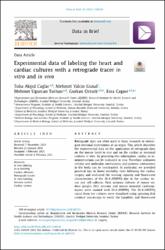| dc.contributor.author | Akgül Çağlar, Tuba | |
| dc.contributor.author | Günal, Mehmet Yalçın | |
| dc.contributor.author | Turhan, Mehmet Uğurcan | |
| dc.contributor.author | Öztürk, Gürkan | |
| dc.contributor.author | Çağavi, Esra | |
| dc.date.accessioned | 2021-03-22T11:10:08Z | |
| dc.date.available | 2021-03-22T11:10:08Z | |
| dc.date.issued | 2021 | en_US |
| dc.identifier.citation | Akgül Çağlar, T., Günal, M. Y., Turhan, M. U., Öztürk, G. ve Çağavi, E. (2021). Experimental data of labeling the heart and cardiac cultures with a retrograde tracer in vitro and in vivo. Data in Brief, 35. https://dx.doi.org/10.1016/j.dib.2021.106834 | en_US |
| dc.identifier.issn | 2352-3409 | |
| dc.identifier.uri | https://dx.doi.org/10.1016/j.dib.2021.106834 | |
| dc.identifier.uri | https://hdl.handle.net/20.500.12511/6642 | |
| dc.description.abstract | Retrograde dyes are often used in basic research to investigate neuronal innervations of an organ. This article describes the experimental data on the application of retrograde dyes on the mouse heart in vivo and on the cardiac or neuronal cultures in vitro. By providing this information, cardiac or inneinnervations can be evaluated in vivo. Therefore, unknown cellular and molecular mechanisms and systemic interactions in the body can be investigated. In particular, we provided practical tips to lower mortality risks following the cardiac surgery and evaluated the staining capacity and fluorescent characteristics of the Di-8-ANEPPQ dye in the cardiac tissue and cell cultures. First, primary cultures of mouse nodose ganglia (NG) neurons and mouse neonatal cardiomyocytes were stained with Di-8-ANEPPQ. The Di-8-ANEPPQ signal from live cultures were visualized using spinning disk confocal microscopy to verify the lipophilic and fluorescent labeling capacity of Di-8-ANEPPQ. Next, the excitation and emission data of Di-8-ANEPPQ were collected between 415 nm and 690 nm using power spectrum module of confocal microscopy. This spectrum analysis could be useful for the researchers who plan to use Di-8-ANEPPQ in combination with other fluorescent dyes to eliminate any florescent overlap. In order to label the heart tissue with tracer dyes Di-8-ANEPPQ or DiI in vivo, the heart was exposed without damaging lungs or other tissues following anesthetization, then the retrograde dye was applied as a paste for DiI or injected to the apex of the heart for Di-8-ANEPPQ and the operation area was sutured. The surgical procedure required intubation to control the respiratory reflex without the need to perform a tracheotomy and yielded high viability. Following labeling the heart in vivo, the heart was dissected, and images of injection area were captured using confocal microscopy. All fluorescent images of Di-8-ANEPPQ labeled cells were analyzed by using the Fiji software. Overall, these data provide applicable data to other investigators to trace the sensory neurons innervating not only the heart but also other organs using Di-8-ANEPPQ. These data support the original research article titled “Evaluation of bilateral cardiac afferent distribution at the spinal and vagal ganglia by retrograde labeling” that was accepted for publication in Brain Research Journal [1]. | en_US |
| dc.language.iso | eng | en_US |
| dc.publisher | Elsevier Inc. | en_US |
| dc.rights | info:eu-repo/semantics/openAccess | en_US |
| dc.rights | Attribution-NonCommercial-NoDerivatives 4.0 International | * |
| dc.rights.uri | https://creativecommons.org/licenses/by-nc-nd/4.0/ | * |
| dc.subject | In Vivo Labeling | en_US |
| dc.subject | Di-8-ANEPPQ | en_US |
| dc.subject | Cardiac Afferents | en_US |
| dc.subject | Retrograde Tracers | en_US |
| dc.subject | In Vitro Labeling | en_US |
| dc.subject | Sensory System | en_US |
| dc.subject | Cardiac System | en_US |
| dc.title | Experimental data of labeling the heart and cardiac cultures with a retrograde tracer in vitro and in vivo | en_US |
| dc.type | other | en_US |
| dc.relation.ispartof | Data in Brief | en_US |
| dc.department | İstanbul Medipol Üniversitesi, Rektörlük, Rejeneratif ve Restoratif Tıp Araştırmaları Merkezi (REMER) | en_US |
| dc.department | İstanbul Medipol Üniversitesi, Rektörlük, Sağlık Bilim ve Teknolojileri Araştırma Enstitüsü | en_US |
| dc.department | İstanbul Medipol Üniversitesi, Sağlık Bilimleri Enstitüsü, Sinirbilim Ana Bilim Dalı | en_US |
| dc.department | İstanbul Medipol Üniversitesi, Sağlık Bilimleri Enstitüsü, Tıbbi Biyoloji ve Genetik Ana Bilim Dalı | en_US |
| dc.department | İstanbul Medipol Üniversitesi, Tıp Fakültesi, Temel Tıp Bilimleri Bölümü, Fizyoloji Ana Bilim Dalı | en_US |
| dc.department | İstanbul Medipol Üniversitesi, Tıp Fakültesi, Temel Tıp Bilimleri Bölümü, Tıbbi Biyoloji Ana Bilim Dalı | en_US |
| dc.authorid | 0000-0003-0352-1947 | en_US |
| dc.authorid | 0000-0002-7199-583X | en_US |
| dc.identifier.volume | 35 | en_US |
| dc.relation.tubitak | info:eu-repo/grantAgreement/TUBITAK/SOBAG/115S381 | |
| dc.relation.publicationcategory | Diğer | en_US |
| dc.identifier.doi | 10.1016/j.dib.2021.106834 | en_US |
| dc.identifier.scopusquality | Q4 | en_US |



















